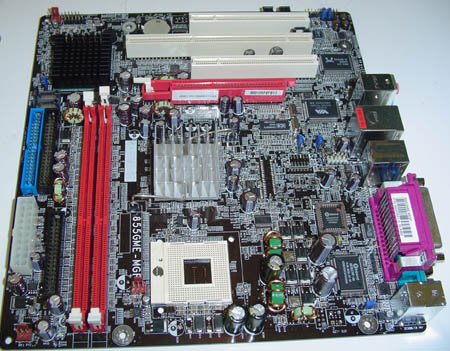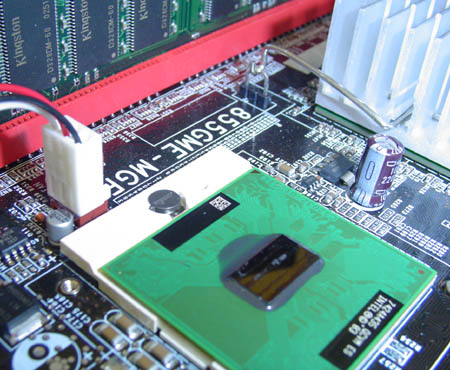Linux and the Desktop Pentium M: Uncommon Performance
by Kristopher Kubicki on December 24, 2004 12:00 PM EST- Posted in
- Linux
Motherboard Details
As we had briefly mentioned earlier, all desktop Dothan/Banias motherboards are all derived from blade configurations. The key term used when describing a blade is density; things tend to be a little smaller, and cost generally takes a back seat to thermal reduction and size reduction. Like a Beowulf cluster, there isn't a lot of need for top of the line, best of breed components so long as the components used are reliable, cool and small. After all, what is a 10% dip in performance on one blade if you can double the number of blades that sit in the same rack?All Pentium M blades run on Intel's notebook 855GME chipset. This chipset really doesn't differ from any other Dothan notebook chipset; DDR1, AGP/PCI, ICH5 and 400MHz front side bus. The 6300ESB southbridge provides a 64-bit PCI-X (not to be confused with PCI-Express) bus, which is generally dedicated to fiber optic networking.
For these sets of benchmarks, we selected the DFI 855GME-MFG motherboard but AOpen also sells a retail i855GME motherboard. Even though both motherboards come in MicroATX form factors and use relatively older bridges, these boards are very expensive - mostly due to the fact that they have no competition! At time of publication, our DFI 855GME-MFG cost a little over $250, which is a considerable amount to pay for a motherboard. On the other hand, if we buy a comparative top of the line Socket 775 motherboard, with all the trimmings, $250 isn't too much to spend.
DFI and AOpen do not differ much in design of their desktop Dothan motherboards, but DFI's board has a few extra amenities. A Realtek gigabit Ethernet port, six-channel VIA audio and Winbond Firewire are also standard on this motherboard - although, we had difficulties getting SUSE 9.1 and the Realtek 8110S Ethernet to play well together due to driver conflicts. For the duration of the analysis, we used an Intel Pro/1000+ Ethernet controller, but that should not affect our benchmarks. Our motherboard only supports a 4X AGP bus, but as we have seen in dozens of benchmarks before, that should hardly affect video performance, if at all.












47 Comments
View All Comments
bhtooefr - Saturday, December 25, 2004 - link
Problems on the John the Ripper section:DES: Where's the 755?
MD5: Where's the 400MHz FSB 765?
Blowfish: Where's the 533MHz FSB 765?
Also, for anyone who wants to know what the heatsink IS, x86-Secret reviewed this before the heatsink was available, and they used a MicroCool northbridge heatsink.
FWIW, I don't know why nobody's coupled this thing to an i865/875. It's definitely possible, as Shelton (0K L2 Banias) has been coupled to an i845, and Banias has been coupled to an E7501. And, the fact that Alviso is "i915GL" says a lot. Mobo makers should be able to simply rework the traces leading to the socket, and reuse their P4 board designs for a P-M board design. Or, if they're REALLY lazy, they could just make an adaptor - put the processor in it, and drop it in the socket.
ImSoHighRightNow - Saturday, December 25, 2004 - link
"Encode rate, more are better"? Some encoding rates can't be "more" than other encoding rates. They can be HIGHER, but not "more". I would suggest "Encoding rates, higher is better"You know what you need? A grammar handbook. Nothing annoys me more than someone who can't conjugate "to be" correctly. I learn conjugations for other languages, the least you can do is learn conjugations for one verb in English. Thanks
ImSoHighRightNow - Saturday, December 25, 2004 - link
"Rendering time in seconds, less are better"Shouldn't that read more like "Rendering time in seconds, fewer is better" or "Rendering time, a shorter amount of time is better"? At least something remotely grammatical would be preferable. Thanks
miketheidiot - Saturday, December 25, 2004 - link
dothan will need work before its ready for desktop. Simple as that. And make it cheaper two, that would be good. $500 + $250 for a mobo is quite a bit, even if it does OC well.DrMrLordX - Friday, December 24, 2004 - link
Looks like the Dothan falls flattest when it's faced with multiple concurrent threads. Dual-core Dothan solutions might alleviate some of that problem, but, perhaps this is one of the reasons why Intel has been rather shy about pushing multi-core Pentium Ms for the desktop?Googer - Friday, December 24, 2004 - link
It seemed to me that the extra performance 133mhz that the 533 bus provides is rather small. My suggestion is couple this with an 875 or 865 chipset @400mhz and let dual channel memory add the needed performance boost. Its probably the cheapest and most effective way to increase the performance of Pentium M.Pannenkoek - Friday, December 24, 2004 - link
I believe that the price of the processor tested should have a more prominent position in the whole test. It's, after all, about the price/performance ratio for most of the consumers.If you plan on testing GCC vs ICC then I recommend to visit http://www.coyotegulch.com (though the site is "temporarily unavailable"), where you can find comparisons between the compilers, compile settings and more.
The focus of the tests on the site is on scientific applications/algorythms which fit in cache, and is therefore more about how many micro-optimizations are not missed. Which explains why results can vary so much; and also why the ICC compiler, made by Intel for Intel processors, can be sometimes a lot faster than GCC, which does not share the intimate knowledge of the inner working of those processors and targets a zillion other architectures as well...
sprockkets - Friday, December 24, 2004 - link
I wish though you included pics of the fully assembled system. I would like to see that HSF, since it appears AOpen simply uses a 478 type heatsink bracket. But looking at the board at newegg.com, the Aopen board comes with the heatsink, and has DUAL Marvell Gbe, plus it has a SATA controller on it as well, and costs $14 less.MDme - Friday, December 24, 2004 - link
Anand and co: when will you guys do a full review of this chip against P4 and A64 across the different applications, games, etc? that would be a great gift to your readers at AT.JustAnAverageGuy - Friday, December 24, 2004 - link
Page 6:"We also took the same POV-Ray benchmark and ran it against the Pentium M clocked at speeds from 1.0GHz to 2.4GHz."
Should read 1.6GHz
[shake 3.5c]"Although it holds up well against an Athlon 64 3200+"
Doesn't seem like it. It took over 12 minutes longer.